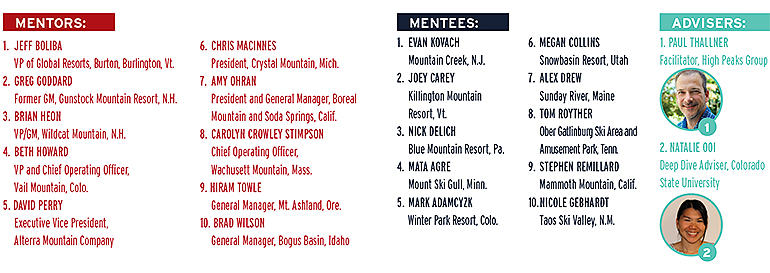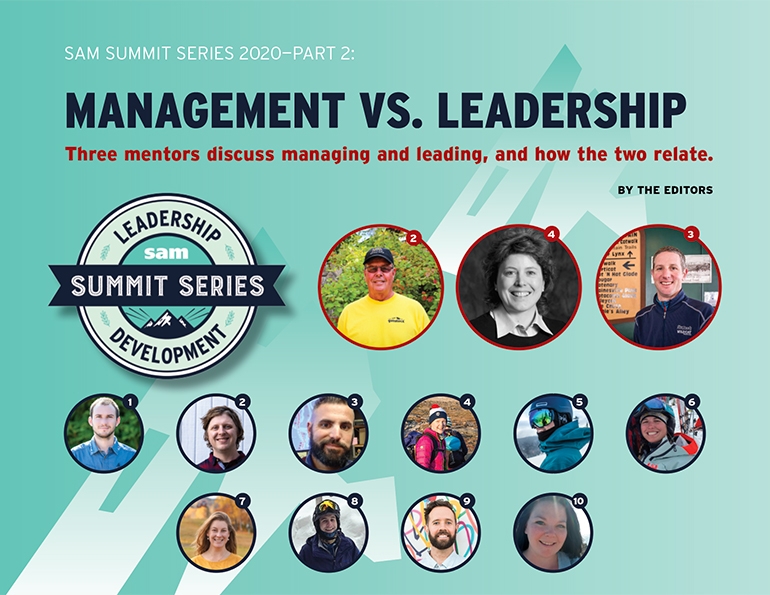

“Management is doing things right; leadership is doing the right things.” —Peter Drucker
The Summit Series kicked off this fall with a mission to connect 10 current industry leaders with 10 next-generation leaders and continue the mentor-mentee dialogue SAM started three years ago. The aim: assist the development of the mountain resort industry’s future generation of leaders.
In our second installment of this year’s Summit Series, we tackled the differences between management and leadership, or, more accurately, what it means to be a good manager, and what it means to be a good leader. The three mentors discussing this important interrelation are accomplished managers and leaders themselves: Beth Howard, COO, Vail Mountain, Colo.; Greg Goddard, recently-retired GM, Gunstock, N.H.; and Brian Heon, GM, Wildcat, N.H.
Throughout the conversation it became clear that, while there is a difference between management and leadership, the two go hand-in-hand.
What’s the Difference?
“I think of management as a process of things, and then I think of the leadership part as being the action that is going to be used to deal with that process,” said Heon.
Process vs. leadership. Goddard put this into perspective by putting himself in the shoes of a rental shop manager. A busy rental shop, of course, needs to have efficient processes in place to manage the various steps guests and staff must go through. “I’m gonna create a process to get guests signed in, get their waiver signed, then move them over to the boot counter and get their boots fitted,” he said.
Staff will know this process inside and out. That’s an example of management duties.
“But my leadership role as the manager of the rental shop would be to get my team to understand what’s in the head of the person that’s coming to rent those skis,” said Goddard. “We need to help guests with their apprehension and with their irritation that they’re standing in a long line, and help them understand why it’s important that their boots fit and coach them through knowing whether they’re even on the right feet.”
A good rental shop manager spends at least as much time coaching staff on soft skills and how to interact with guests as he or she does in training to processes and procedures. And so it is with most managers. It’s one thing to establish a brilliant process, and a whole other thing to convince and inspire a staff to enthusiastically put that process into effect.
Process and purpose. Howard agreed. “I’ve always looked at management more on the administrative side, getting things done and being really effective in logistics, communications, calendars—all of those things,” she said. The leadership aspect “has always blended in with more of the inspirational side, making sure we’re aligned around the vision and purpose of what we’re doing, and keeping the most meaningful work prioritized.”
What Makes an Effective Manager?
Results matter. “It’s all about getting the outcomes and results that you want and you set out to do,” Howard said. “I think making sure that we’re bringing the team along in that effort is truly when you can measure or differentiate an effective or noneffective manager.”
It’s important to remember that managers aren’t always responsible for supervising people. He or she may manage an aspect of the business: scheduling, merchandising, or a snowmaking control room, for example. None of these managers work on an island alone, though. To do their jobs best, they must work with others, get feedback, ask the right questions, and have answers when questions are asked of them to achieve the desired results.
Explaining “why.” It’s all part of “bringing the team along in that effort,” as Howard mentioned. An effective manager must be able to answer “why?”
“When people understand why, they may not necessarily agree with the decision, but at least if they have context, that can help bring them on board and get to the end goal,” Howard said.
Using time wisely. Knowing where and when to put the most effort into something is also vital, according to Goddard. “I think probably the most important thing for me is time and priority management,” he said. A manager has to know his or her priorities.
Being flexible. And then a manager needs the flexibility to change those priorities as circumstances unfold. Inevitably, priorities are going to change depending on the season, the day, or the situation. “Knowing when to shift gears and to change priorities is key to being effective over the long haul,” Goddard said.
General Knowledge vs. Expertise
A strong leader knows his or her limitations as well as strengths. Being familiar with various aspects of the department or resort you lead is part of being a leader, but trying to know and do everything just isn’t reasonable. That’s why leaders need good managers.
Rely on others for expertise. “I really rely on a lot of managers that work with me to be the experts in their field, whether it’s snowmaking or lifts or food and beverage,” said Heon. “They’re the ones that are really managing the process, with me just helping to lead them to success.”
Along those same lines, Heon alluded to the importance of being humble. When facilitator Paul Thallner asked the mentors to share something they learned early in their career, Heon said, “I think that the days of being this leader with all of the answers is certainly a thing of the past.” Strength comes in looking to others on your team “for knowledge and advice in order to lead the whole team across the finish line.”
Goddard shared this sentiment. “I learned early on the importance of understanding that there are experts in our industry that are not me,” said Goddard.
When asked to share advice for the mentees learned from mistakes she made early in her career, Howard echoed Heon and Goddard, saying one of the biggest mistakes she made was thinking she had to be an expert at everything in order to effectively lead. “However, as you progress as a leader, you become more of a generalist and less of a specialist,” she said.
Needed: a holistic view. This growth of general knowledge and confidence to trust in managers allows leaders to have a more holistic view of the entire enterprise. They can look at things from the 30,000-foot level and develop an overall direction for their company or department. But if managers and others aren’t fully aware, or can’t see what the leader is seeing, there will be a major disconnect.
Sharing the view. “Make sure that you’re constantly sharing your vision so that people understand why you and the company are doing the things you’re doing,” advised Goddard.
Listen Up
Communication is a two-way street, which is especially important to remember when in a leadership role. That’s why, in this call about leadership vs. management, the mentors were asked, “How do you ensure employees feel heard?”
Listen carefully. “One thing personally that I’ve been working on is not just listening, but being an active listener,” said Heon. When an employee brings up something directly with him, he wants to take the time to talk through it while the idea or issue is fresh in the employee’s mind.
“That’s when I try to put my phone aside, not type, look them in the eye, ask questions,” he said. “They brought it up for a reason. They’ve probably been thinking about it for a while.”
Howard stressed the importance of establishing “a culture where feedback is a part of how we work together,” she said.
Follow up. “I think the most important thing is if they pitch an idea to you—whether you’re in the maze or they send you an email or text or something—always listen and always follow up,” said Howard. “Whether it’s you following up or someone on your team, always follow up. And the answer may be yes, no, or maybe in the future, and give the ‘why’ behind that response. I think that builds credibility and trust that we’re listening.”
There are many differences between management and leadership. In simple terms, you manage a process and lead people. At least one thing is the same in both cases: to do one or the other effectively, there must be good communication.






